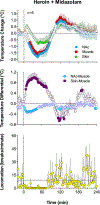Interactions of benzodiazepines with heroin: Respiratory depression, temperature effects, and behavior
- PMID: 31228487
- PMCID: PMC6745248
- DOI: 10.1016/j.neuropharm.2019.107677
Interactions of benzodiazepines with heroin: Respiratory depression, temperature effects, and behavior
Abstract
Benzodiazepines are important therapeutic drugs, but they are often abused and co-abused with opioids. Clinical evidence suggests that benzodiazepines can inhibit respiration, and when combined with the respiratory-depressive effects of opioids, may increase likelihood of death. In this study we used oxygen sensors coupled with high-speed amperometry and multi-site thermorecording to examine how intravenous (iv) midazolam, a potent benzodiazepine, modulates the brain hypoxic and temperature effects of iv heroin in freely-moving rats. Oxygen levels and brain temperature were assessed with high temporal resolution in the nucleus accumbens (NAc), an important structure in the motivational-reinforcement circuit. When administered alone, midazolam (2 mg/kg) modestly decreased NAc temperature but had no evident effects on oxygen levels in this structure. In contrast, heroin (0.4 mg/kg) induced a strong decrease in NAc oxygen that was followed by a weaker, rebound-like oxygen increase. Midazolam pretreatment did not affect heroin-induced brain hypoxia but potentiated the initial hypothermia induced by heroin. However, co-administration of these drugs potentiated the heroin-induced oxygen decrease and enhanced heroin-induced brain hypothermia. Co-administration of heroin and midazolam also resulted in enhanced locomotor inhibition and loss of motor control. This effect caused some rats to collapse, resulting in nose and mouth occlusion, which caused a secondary hypoxic phase. These results could have important implications for human drug users, as the combined use of benzodiazepines with potent opioids not only results in sustained brain hypoxia but creates conditions of loss of motor control which could result in asphyxia and death. This article is part of the Special Issue entitled 'New Vistas in Opioid Pharmacology'.
Keywords: Brain hypoxia; Midazolam; Nucleus accumbens; Opiates; Rats; Vasoconstriction/vasodilation.
Published by Elsevier Ltd.
Conflict of interest statement
Figures





Similar articles
-
Hypoxic effects of heroin and fentanyl and their basic physiological mechanisms.Am J Physiol Lung Cell Mol Physiol. 2024 Dec 1;327(6):L930-L948. doi: 10.1152/ajplung.00251.2024. Epub 2024 Oct 15. Am J Physiol Lung Cell Mol Physiol. 2024. PMID: 39404797 Review.
-
Heroin Contaminated with Fentanyl Dramatically Enhances Brain Hypoxia and Induces Brain Hypothermia.eNeuro. 2017 Oct 30;4(5):ENEURO.0323-17.2017. doi: 10.1523/ENEURO.0323-17.2017. eCollection 2017 Sep-Oct. eNeuro. 2017. PMID: 29085909 Free PMC article.
-
Intravenous Heroin Induces Rapid Brain Hypoxia and Hyperglycemia that Precede Brain Metabolic Response.eNeuro. 2017 Jun 7;4(3):ENEURO.0151-17.2017. doi: 10.1523/ENEURO.0151-17.2017. eCollection 2017 May-Jun. eNeuro. 2017. PMID: 28593192 Free PMC article.
-
Changes in brain oxygen and glucose induced by oxycodone: Relationships with brain temperature and peripheral vascular tone.Neuropharmacology. 2018 May 1;133:481-490. doi: 10.1016/j.neuropharm.2018.02.017. Epub 2018 Feb 21. Neuropharmacology. 2018. PMID: 29476778 Free PMC article.
-
Respiratory depression and brain hypoxia induced by opioid drugs: Morphine, oxycodone, heroin, and fentanyl.Neuropharmacology. 2019 Jun;151:219-226. doi: 10.1016/j.neuropharm.2019.02.008. Epub 2019 Feb 5. Neuropharmacology. 2019. PMID: 30735692 Free PMC article. Review.
Cited by
-
Basic metabolic and vascular effects of ketamine and its interaction with fentanyl.Neuropharmacology. 2023 May 1;228:109465. doi: 10.1016/j.neuropharm.2023.109465. Epub 2023 Feb 18. Neuropharmacology. 2023. PMID: 36801400 Free PMC article.
-
A Forensic Diagnostic Algorithm for Drug-Related Deaths: A Case Series.Toxics. 2022 Mar 22;10(4):152. doi: 10.3390/toxics10040152. Toxics. 2022. PMID: 35448413 Free PMC article.
-
Hypoxic effects of heroin and fentanyl and their basic physiological mechanisms.Am J Physiol Lung Cell Mol Physiol. 2024 Dec 1;327(6):L930-L948. doi: 10.1152/ajplung.00251.2024. Epub 2024 Oct 15. Am J Physiol Lung Cell Mol Physiol. 2024. PMID: 39404797 Review.
-
Piloting the UK's First Home-Office-Licensed Pharmacist-Led Drug Checking Service at a Community Substance Misuse Service.Behav Sci (Basel). 2020 Jul 25;10(8):121. doi: 10.3390/bs10080121. Behav Sci (Basel). 2020. PMID: 32722508 Free PMC article.
-
Intimate partner violence, substance use, and health comorbidities among women: A narrative review.Front Psychol. 2023 Jan 27;13:1028375. doi: 10.3389/fpsyg.2022.1028375. eCollection 2022. Front Psychol. 2023. PMID: 36778165 Free PMC article. Review.
References
-
- Baud FJ (2009). Mechanisms of opioid-induced overdose: experimental approach to clinical concerns. Ann. Pharm. Fr 67, 353–359. - PubMed
-
- Bolger FB, Bennett R, and Lowry JP (2011). An in vitro characterization comparing carbon paste and Pt microelectrodes for real-time detection of brain tissue oxygen. Analyst 136, 4028–4035. - PubMed
-
- Brown PL, and Kiyatkin EA (2004). Brain hyperthermia induced by MDMA (ecstasy): modulation by environmental conditions. Eur. J. Neurosci 20, 51–58. - PubMed
Publication types
MeSH terms
Substances
Grants and funding
LinkOut - more resources
Full Text Sources

